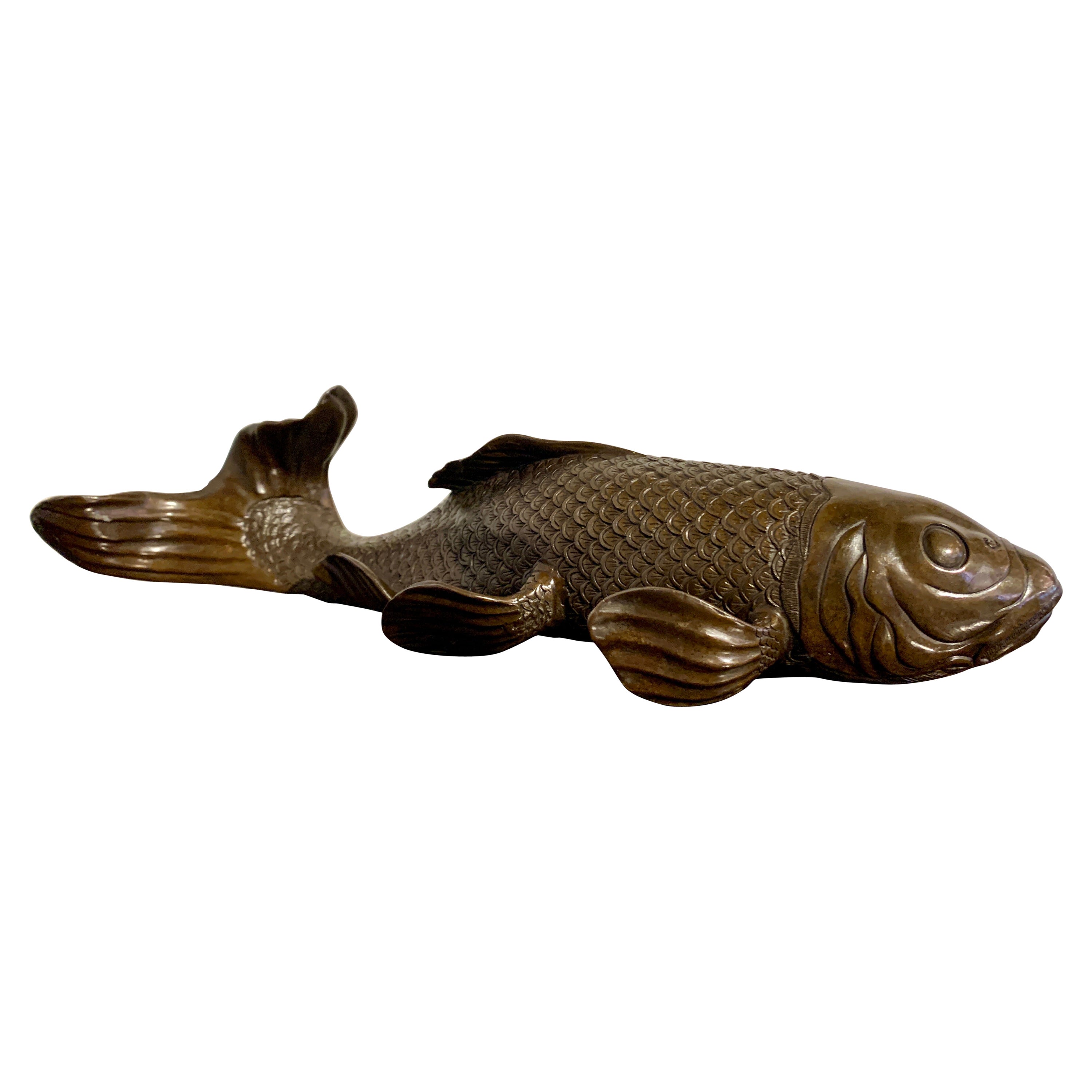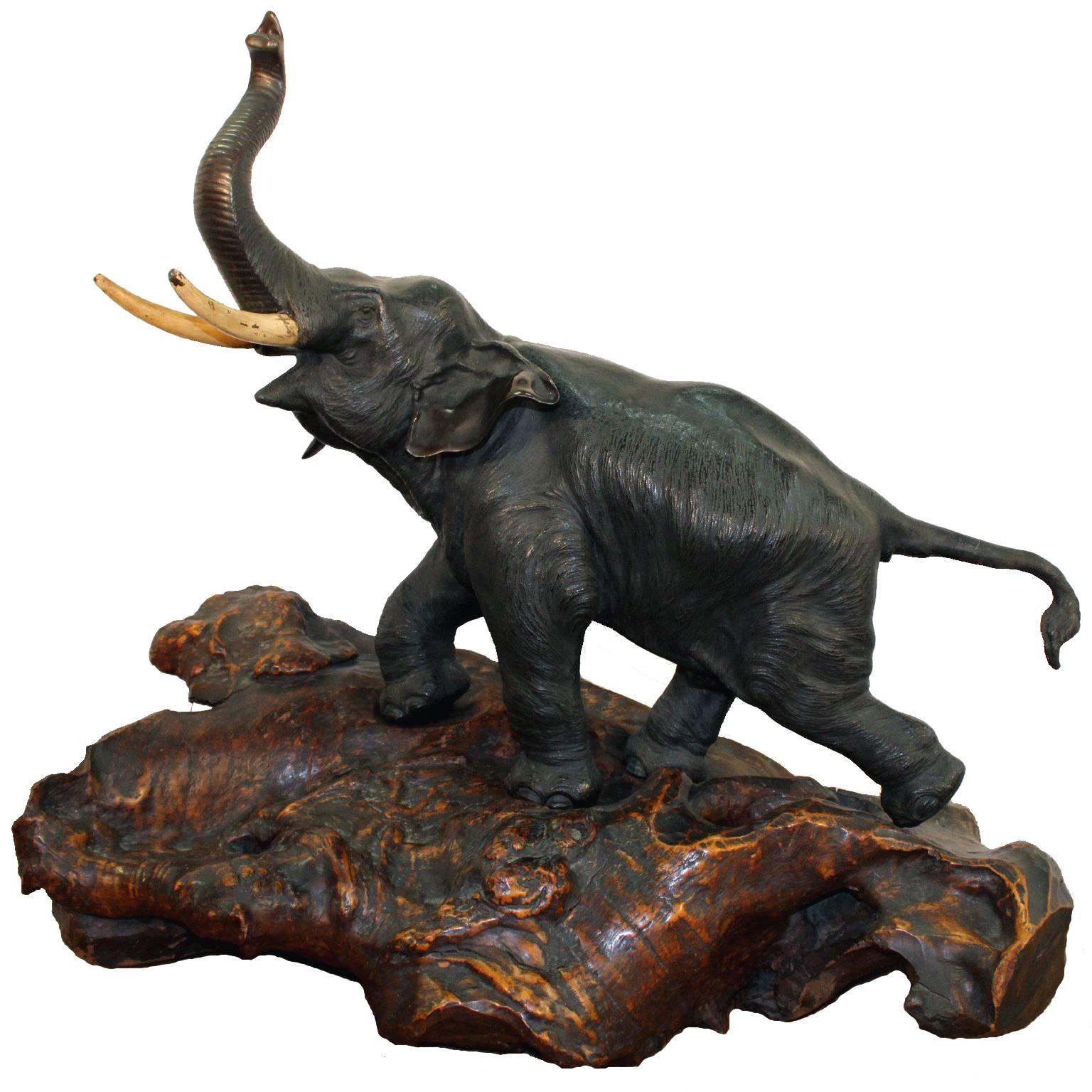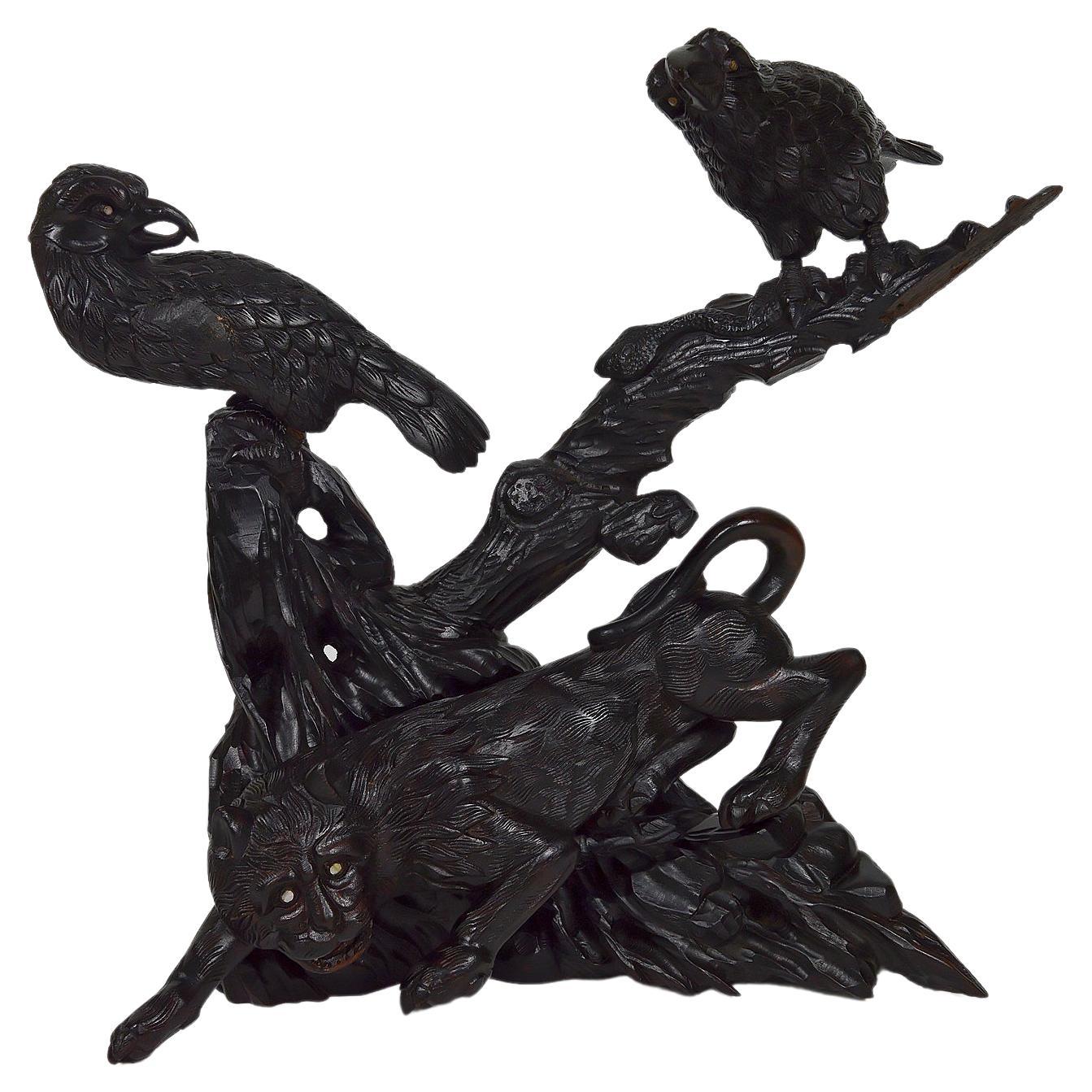Items Similar to Japanese Tokyo School Bronze Okimono of a Farmer, Meiji Period
Want more images or videos?
Request additional images or videos from the seller
Japanese Tokyo School Bronze Okimono of a Farmer, Meiji Period
About the Item
A very fine and detailed Tokyo School cast bronze okimono (decorative sculpture) of a smiling farmer, Meiji period, late 19th century, Japan.
The elderly farmer is portrayed standing upon a patch of earth, a hoe in one hand, an awl in the other. He is dressed in loose fitting clothes, comprised of a kosode under a hanten, both tied at the waist, and a pair of trousers tied above the knees. His feet bare. The short hanten outer garment decorated with beautiful floral roundels.
The farmer's face is set in a joyous smile, with a wide, tooth bearing grin on his wrinkled face. His hair in the traditional chonmage style topknot.
The bronze wonderfully warm, with a reddish hue to the chocolate brown bronze. The bronze with thin clear lacquer coating.
- Dimensions:Height: 11 in (27.94 cm)Width: 4.38 in (11.13 cm)Depth: 3 in (7.62 cm)
- Style:Meiji (Of the Period)
- Materials and Techniques:Bronze,Cast
- Place of Origin:
- Period:
- Date of Manufacture:circa 1880
- Condition:Wear consistent with age and use. Some minor scratching to the back of the figure, as seen in photos.
- Seller Location:Austin, TX
- Reference Number:1stDibs: LU894721090872
About the Seller
5.0
Platinum Seller
These expertly vetted sellers are 1stDibs' most experienced sellers and are rated highest by our customers.
Established in 2001
1stDibs seller since 2010
306 sales on 1stDibs
Typical response time: 1 hour
- ShippingRetrieving quote...Ships From: Austin, TX
- Return PolicyA return for this item may be initiated within 7 days of delivery.
More From This SellerView All
- Japanese Bronze Okimono of a Carp, Taisho Period, Early 20th Century, JapanLocated in Austin, TXAn elegant Japanese cast bronze okimono of a swimming carp, Taisho Period (1912 - 1926), early 20th century, Japan. The graceful fish portrayed realistically in motion, as if swimmi...Category
Vintage 1920s Japanese Taisho Sculptures and Carvings
MaterialsBronze
- Pair of Japanese Gilt Bronze Komainu by Ishikawa Komei, Meiji PeriodLocated in Austin, TXA striking pair of Japanese gilt bronze komainu by the renowned Japanese sculptor, Ishikawa Komei (1852-1913), Meiji period, Japan. The pair well cast, and robustly modeled. They ar...Category
Antique Late 19th Century Japanese Meiji Sculptures and Carvings
MaterialsBronze
- Pair of Japanese Cast Bronze Figures of Niō, Meiji Period, Late 19th CenturyLocated in Austin, TXA well cast pair of Japanese mixed metal okimono figures of Buddhist guardians, known as Nio or Dharmapala, protectors of Buddhist faith, Meiji Period, Japan. The smiling bronze g...Category
Antique Late 19th Century Japanese Meiji Sculptures and Carvings
MaterialsBronze
- Japanese Gilt Wood Fukukenjaku Kannon, Meiji Period or Earlier, JapanLocated in Austin, TXAn attractive and esoteric Japanese carved and gilt wood figure of Fukukenjaku Kannon, Amoghapasa, Meiji period or earlier, Japan. Fukukenjaku Kannon is portrayed in an usual six...Category
Antique Early 1900s Japanese Meiji Sculptures and Carvings
MaterialsCypress
- Japanese Painted Bronze Okimono of a Gourd by Toyo, Showa Era, 1960s, JapanBy ToyoLocated in Austin, TXA charming Japanese decorative bronze sculpture, okimono, of a gourd, hyotan, by Toyo Japan, Showa Era, circa 1960s, Japan. The realistic okimono, fashio...Category
Vintage 1960s Japanese Showa Sculptures and Carvings
MaterialsBronze
- Japanese Miyao Style Gilt Bronze Samurai Archer, Meiji Period, JapanBy Eisuke Miyao 1Located in Austin, TXA spectacular Japanese cast, carved, and parcel gilt bronze sculpture, okimono, of a kneeling samurai archer, signed Kiyotsugu (died 1894), Meiji ...Category
Antique Late 19th Century Japanese Meiji Sculptures and Carvings
MaterialsBronze
You May Also Like
- Japanese Meiji Period Carved Wood Okimono Man with RabbitsLocated in Newark, EnglandThe charming figure, carved from a single piece of wood is exceptionally carved showing the male figure with humorous expression holding two Rabbits one by the ears and the second under his arm. A third Rabbit stands at the feet of the male looking up, each rabbit with a different expression. The male figure is wearing traditional Japanese attire with his hair tied back stood upon a naturalistic base. The figure dates to the Meiji Period (1868-1912) circa 1900. Notes The Rabbit is one of the 12 animals to feature in the Japanese Zodiac signs which follows the Chinese astrological system along with the Rat, Ox, Tiger, Rabbit, Dragon, Snake, Horse, Goat, Monkey, Rooster, Dog, Pig. Such division is connected with the Jupiter cycle around the Sun, which lasts about 12 years. As 2023 is the year of the Rabbit...Category
Antique Early 1900s Japanese Meiji Sculptures and Carvings
MaterialsWood
- Japanese Meiji Period Bronze Elephant Sculpture on Burlwood BaseLocated in New York, NYA Japanese Meiji period bronze elephant sculpture on its original burl-wood base. Old repair to the tail; some paint chips to bronze trunk; unsigned.Category
Antique 1880s Japanese Meiji Animal Sculptures
MaterialsBronze
- Asian Sculpture / Okimono with Lion and Crows, Japan, Meiji Era, circa 1880Located in VÉZELAY, FRRare and important Japanese sculpture / statue / okimono in blackened and carved wood, depicting 1 lion, 2 birds (crows or other birds of prey) and 1 snake held in the claws of one o...Category
Antique 1880s Japanese Meiji Sculptures and Carvings
MaterialsWood
- Japanese Meiji Bronze Sea-Hawk SculptureLocated in New York, NYA finely-cast large Japanese Meiji-period bronze sculpture of a sea-hawk with stretched-out wings, made in the 1880s. The eyes are gilded; both wings and the body of the hawk are det...Category
Antique 1880s Japanese Meiji Sculptures and Carvings
MaterialsBronze
- Meiji Period Bronze of an Oni Holding a ParasolLocated in Lymington, HampshireThis figural group shows a mendicant Oni with a tattered umbrella and wearing a voluminous shakudo cloak over gilt tiger mask greaves. A smaller Oni wears s...Category
Antique 1890s Japanese Meiji Figurative Sculptures
MaterialsMetal
- Japan 1890 Meiji Period Signed Okimono Sculpture of a Group of Skeletons SmokingLocated in Miami, FLSculptural signed Okimono from the Japanese Meiji period (1868-1912). Very rare, unusual and large sculptural assembling of a dysplaying piece of okimono. Created in Japan during the imperial period of the Meiji (1868-1912). This extraordinary okimono was carefully carved depicting a group of three intricately and realistically rendered carousing skeletons (Gaikotsu) in relax and resting position, drinking and smoking. Two of them, probably males representations are resting on a wicker sofa. The third, is a woman seated in a lower stool offering drinking cups of sake on a round tray. A small rectangular bench is arranged in the scene. The composition is displayed on a four-legged carved wood platform with an inlaid red plaque engraved with the artist's signature. The level of detail and the quality of the carving is truly exceptional. Has an exact measurements of 209.55 mm by 196.85 mm by 127.76 mm (8.25 x 7.75 x 5.03 Inches). After an extensive collection of data, comparables and references to this piece, we have only been able to find only three okimono sculptures like this with similar themes and the same quality of work. References Note: A similar carving of four skeletons playing an animated game of dominos, signed Shutaro in an inlaid rectangular red plaque, was sold in London by Christie’s South Kensington in October 14 2014, Lot 120 Sale 5546. References Note: A similar carving with four skeletons in an otherwise typical victorian scene of a photographer and three sitters signed Shutaro in an inlaid rectangular red plaque, was sold in Edinburgh at Lyon & Turnbull in November 7, 2018. References Note: A similar carving with five skeletons seated, playing cards and drinking, was sold in London by John Nicholson Fine Art on September 26, 2018. Meiji period, is an era of Japanese history that extended from October 23, 1868 to July 30, 1912. The Meiji era was the first half of the Empire of Japan, when the Japanese people moved from being an isolated feudal society at risk of colonization by Western powers to the new paradigm of a modern, industrialized nation state and emergent great power, influenced by Western scientific, technological, philosophical, political, legal, and aesthetic ideas. As a result of such wholesale adoption of radically different ideas, the changes to Japan were profound, and affected its social structure, internal politics, economy, military, and foreign relations. The period corresponded to the reign of Emperor Meiji. It was preceded by the Keio era and was succeeded by the Taisho era, upon the accession of Emperor Taisho. Okimono, is a Japanese term meaning for display an ornament; art object; or decorative object, usually displayed in a tokonoma or butsudan "Buddhist altar". It is an ornament or figure, especially one placed in a guest room. An okimono may be a small Japanese...Category
Antique 1890s Japanese Meiji Sculptures and Carvings
MaterialsWood
Recently Viewed
View AllMore Ways To Browse
Browned Bronze
Set Of Carvings
Gold Barer
Tokyo Used Furniture
Carvings Of Faces
Gold Carving Set
Antique Farmer
Japanese Hair
Japanese Style Dress
Antique Japanese Bronze Sculpture
Japanese Patches
Japanese Meiji Carving
Japanese Hand Warmer
Pair Of Roundels
Asian Bronze Face
Bronze Floral Sculpture
Antique Furniture Tokyo
Meiji Bronze Sculpture





